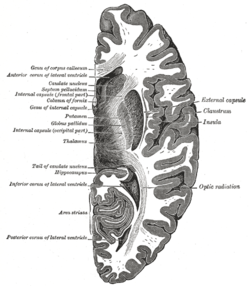Thelentiform nucleus(orlentiform complex,lenticular nucleus,orlenticular complex) are theputamen(laterally) and theglobus pallidus(medially), collectively. Due to their proximity, these two structures were formerly considered one, however, the two are separated by a thin layer ofwhite matter—the external medullary lamina—and are functionally and connectionally distinct.[1]
| Lentiform nucleus | |
|---|---|
 Putamenandglobus pallidusmake up the lentiform nucleus. | |
 Two views of a model of thestriatum(i.e. lentiform nucleus plus thecaudate nucleus) of the right cerebral hemisphere: A,lateralaspect; B,medialaspect | |
| Details | |
| Identifiers | |
| Latin | nucleus lentiformis |
| NeuroNames | 1234 |
| TA98 | A14.1.09.506 |
| TA2 | 5567 |
| FMA | 77615 |
| Anatomical terms of neuroanatomy | |
The lentiform nucleus is a large, lens-shaped mass ofgray matterjust lateral to theinternal capsule.It forms part of thebasal ganglia.With thecaudate nucleus,it forms thedorsal striatum.
Structure
editWhen divided horizontally, it exhibits, to some extent, the appearance of a biconvex lens, while acoronal sectionof its central part presents a somewhat triangular outline.
It is shorter than the caudate nucleus and does not extend as far forward.
Relations
editIt is deep/medial to theinsular cortex,with which it is coextensive; the two are separated by intervening structures.[1]
It is lateral to the caudate nucleus andthalamus,and is seen only in sections of the hemisphere.
It is bounded laterally by a lamina of a white substance called theexternal capsule,and lateral to this is a thin layer of gray substance termed theclaustrum.
Its anterior end is continuous with the lower part of the head of the caudate nucleus and with theanterior perforated substance.
Inferiorly, there is a groove upon the surface of the lenticular nucleus that accommodates theanterior commissure.[1]
Components
editIn a coronal section through the middle of the lentiform nucleus, two medullary laminae are seen dividing it into three parts.
The lateral and largest part is of a reddish color, and is known as theputamen,while the medial and intermediate are of a yellowish tint, and together constitute theglobus pallidus;all three are marked by fine radiating white fibers, which are most distinct in the putamen.
Pathology
editThis sectionneeds expansion.You can help byadding to it.(September 2022) |
Increased volume of the lentiform nuclei has been observed inobsessive–compulsive disorder,with decreased volume conversely observed in other anxiety disorders.[citation needed]
The lentiform nucleus is involved in the pathology ofWilson's diseaseas it is one of the neuroanatomical locations of copper deposition.[citation needed]
Etymology
editThe name comes fromLatinand meanslens-shaped, probably referring to the appearance of the nucleus from the side.
Gallery
edit-
Schematic representation of the chief ganglionic categories (I to V)
-
Dissection of brain-stem. Lateral view.
-
Superficial dissection of brain-stem. Ventral view.
-
Transverse section through mid-brain
-
Section of brain showing upper surface of temporal lobe
-
Coronal section of brain immediately in front of pons
-
Coronal section through anterior cornua of lateral ventricles
-
Ventricles of brain and basal ganglia. Superior view. Horizontal section. Deep dissection.
-
Ventricles of brain and basal ganglia. Superior view. Horizontal section. Deep dissection.
See also
editReferences
editThis article incorporates text in thepublic domainfrompage 834of the 20th edition ofGray's Anatomy(1918)
- ^abcStandring, Susan (2020).Gray's Anatomy: The Anatomical Basis of Clinical Practice(42nd ed.). New York. pp.503–504.ISBN978-0-7020-7707-4.OCLC1201341621.
{{cite book}}:CS1 maint: location missing publisher (link)
External links
edit- "Anatomy diagram: 13048.000-2".Roche Lexicon - illustrated navigator.Elsevier. Archived fromthe originalon 2012-07-22.